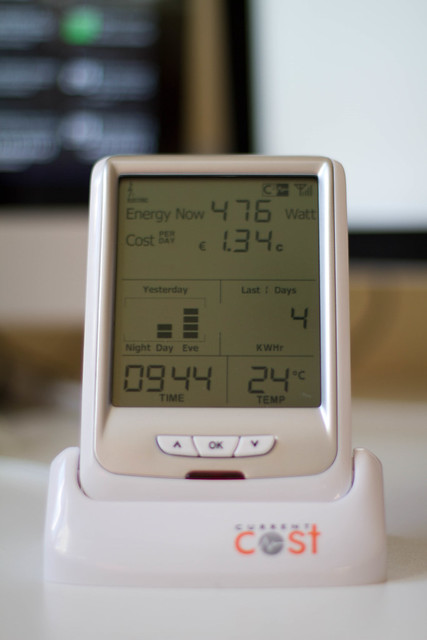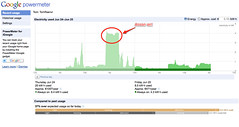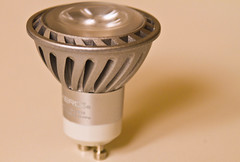
Photo credit Tom Raftery
I emailed Chris Dalby of Current Cost a question about their devices a few weeks ago. Chris, not only answered my question but also offered to send me one of their energy monitors to try for myself!
I love my Current Cost Envi 128. It is incredibly straightforward to setup – even I could do it, despite living in an apartment complex with no access to the electricity meter. I had mine up and running within minutes of receiving the delivery (I attached the clamp to the wire going into the fuseboard)!
One of the really great things about the Current Cost energy meters is that they can be connected to a computer. This may not sound like a big deal but it means you can use software from the downloads page to chart your energy usage in real-time as well as for storing historical data. This allows for fascinating comparisons of energy use across different scenarios.
Recently Current Cost announced they were partnering with Google to allow Google’s PowerMeter software to be used with Current Cost meters.
The software for Google PowerMeter is available on the Current Cost site [after registration]. One disappointing aspect of the Powermeter software is that it is Windows only. Fortunately I have Windows installed (via Parallels) on my Mac so this wasn’t a major issue for me.
The biggest issue I came across with the Current Cost Envi and PowerMeter software is, if you want an accurate picture of your energy use, you need to leave your computer turned on running the PowerMeter software all the time! Obviously this is not very energy-efficient!
There is an historical data upload mode on the Envi. This allows you to upload data from the meter to the software in the case that the software wasn’t running (computer powered down, for example) but the historical data stored on the Envi is not at all granular, and worse, it overwrites the granular data which you had previously uploaded!
Current Cost say they are coming out with a Bridge device which will address this problem. Personally rather than forcing people into buying another device, I’d prefer if the software would simply not overwrite good data – that should be a simple software fix. The lack of granularity in the stored data is a tougher fix but I suspect could also be done via a software update of the Envi (while trading off the number of days’ data the Envi could store).
Apart from these niggles, I think the Current Cost energy meters are a superb way to visualise and track your energy consumption, something that is invaluable in helping to better manage your electricity usage.
I mentioned my concerns to Current Cost and asked for comment from them. As soon as they send me their comments, I will publish them here.
You should follow me on twitter here.



